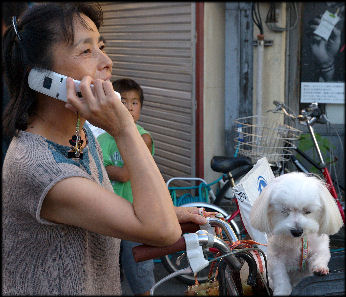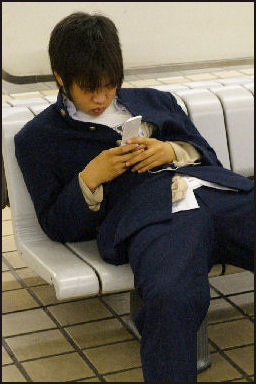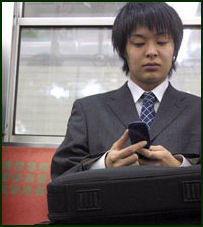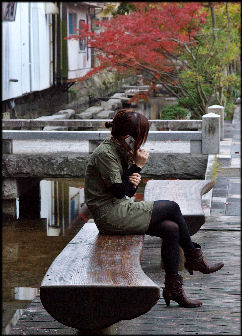CELL PHONE USERS IN JAPAN
 Cell phones are called keitai in Japan. They are cheap, sophisticated and have been connected to the Internet for more than a decade. Cell phone culture adapts itself well to Japan because Japanese spend a lot of time on trains which lends itself to fiddling around on a cell phone as opposed to sitting in car where theoretically you need two hands to drive.
Cell phones are called keitai in Japan. They are cheap, sophisticated and have been connected to the Internet for more than a decade. Cell phone culture adapts itself well to Japan because Japanese spend a lot of time on trains which lends itself to fiddling around on a cell phone as opposed to sitting in car where theoretically you need two hands to drive.
Japanese are arguably way ahead of the rest of the world in their absorption into the cell phone world and their reliance on and use of the devices. A generation has now grow up using cell phones to communicate, shop, play games, watch television, surf the Internet and using cell phones in ways that Americans have only begun to investigate.
As of 2007, 82 percent of Japanese between 10 and 29 use cell phones.
Japan is the world’s third largest cell phone market, with revenues reaching $73 billion in 2004. In January 2007, the number of cell phone subscribers in Japan reached 100 million. A surge in subscriptions had been boosted by lower phone rates and an popularity of music distribution services and an increase in subscriptions among younger and older people. The number of cell phones topped 50 million in March 2000
The sound of personalized cell phone rings is common place in Japan. It is not unusual to see a group of four or five Japanese sitting around talking — but talking not to each other but into their cell phones. Many people ride bicycles thumbing away on their cell phones.
Japanese spend a lot of time sitting on trains and subways rather than driving and sending e-mail or playing games on a cell phone is a great way to kill time while on the move. Japanese are also often very shy and often find communicating on a cell phone easier than talking. One cell phone user who uses her mainly for beach and weather reports told AP, "I rarely use this for talking. I just get on, get the information I want and get off."
Links in this Website: MEDIA, RADIO, NEWSPAPERS AND TELEVISION IN JAPAN Factsanddetails.com/Japan ; TELEVISION PROGRAMS IN JAPAN Factsanddetails.com/Japan ; CHILDREN’s TELEVISION SHOWS IN JAPAN Factsanddetails.com/Japan ; INTERNET IN JAPAN Factsanddetails.com/Japan ; COMMUNICATIONS IN JAPAN Factsanddetails.com/Japan ; CELL PHONES IN JAPAN Factsanddetails.com/Japan ; USES OF CELL PHONES IN JAPAN Factsanddetails.com/Japan ;
Good Websites and Sources: Wikipedia article on Japan’s Cell Phone Culture Wikipedia ; Good Photos at Japan-Photo Archive japan-photo.de ; Academic article on Cell Phones and Japan’s Youth itofisher.com ; Japan Times article on Cell Phone Culture japantimes.co.jp ; Personal, Portable, Pedestrian /mitpress.mit.edu ; 2009 New York Times article on Why Japan’s Smart Phones Have Not Gone Global nytimes.com ;Cool Japanese Cell Phones crunchgear.com/ ; Ministry of Iternal Affairs and Telecommunications soumu.go.jp ; Statistical Handbook of Japan Informatin and Communications Section stat.go.jp/english/data/handbook ; 2010 Edition stat.go.jp/english/data/nenkan ; News stat.go.jp
Cell Phone Companies: Docomo nttdocomo.com ; Softbank mb.softbank.jp/en ; AU by KDDI au.kddi.com/english ; Cell Phone Novels: Mobile Phone Novel handyroman.net ; More on Cell Phone Novels futureofthebook.org ; New York Times article on Cell Phone Novels nytimes.com
Children and Cell Phones in Japan

According to 2008 government statistics 31 percent of primary school students carry cell phones. DoCoMo Mo offers a line of cell phones for small children, with software ranging from picture books to school scheduling pads aimed at helping them to learn. In 2001, only 10 percent of Japanese elementary-school and middle-school-age kids had their own cell phones.
Many of cell phone companies offer special pre-paid devices designed specifically for kids. Parent purchase preset limits on how many minutes their children can use as a sort of allowance. This keeps them from racking up $150 a month cell phone bills.
Parents use cell phones to keep tabs on their kids. Some are outfit with GPS devices connected to a system that provides parents with a faxed map showing their child's location. The same devices are used to locate elderly people with Alzheimer's disease.
New phones with GPS can locate a caller who dials the 110 or 119 emergency numbers. Models for children have a GPS locator and emergency alarms. A couple of companies offer services in which users are given directions to a destination from a starting point identified by the GPS.
Cell phone companies have introduced website filtering services to stop children from cess harmful sites but the filters have loopholes and easily skirted,
Cell Phones and Children
In January 2010, the city of Kanazawa passed a law the obligates parents to prevent primary and middle school children from carrying cell phones except during disasters and for crime prevention. The rule failed to have much of an impact in part because there were no punishment for violations. It didn’t help either that around the same time cell phone companies were offering discounts to students who signed up for their services.
Some highly-publicized cases have brought attention to abuses involving minors and cell phones. There was one case where a high school student hit another student with a baseball bat over a posting on a cell phone site. In another case a female middle school students used counterfeit money she received for providing sexual services to a man she met on a mobile phone dating system. There has been other reports sexual activity involving primary and middle school girls with men they met through cell phone dating sites. Efforts to make cell phones less prone to abuse include phones that can not call outside a list of designated numbers and those that do not connect to the Internet
One survey found that 20 percent of high school girls own two phones, and some own even more. Some convenience store managers have become so annoyed but young people charging their phones at their stores they have taped over the outlets.
Cell Phones and Brain Cancer
An international study released in May 2011 on links between cell phone use and two types of brain cancer were inconclusive. According to the report by the World Health Organization (WTO) , there was “suggestion that using a cell phone for more than 30 minutes each day could increase the risk of glioma — a rare but deadly form of brain cancer — but added that “biases and errors prevent a causal interpretation” of the data. Reuters reported: “Using a mobile phone might increase the risk of developing certain types of brain tumors and consumers should consider ways of reducing their exposure, World Health Organization (WHO) cancer experts said.”
Bryan Walsh wrote in Time, “31 scientists from the International Agency for Research on Cancer (IARC) — the WHO body that does what its name says — spent a week reviewing the latest studies on cancer and cell-phone-radiation exposure. And to the surprise of many cancer experts, IARC classified cell-phone-radiation exposure as "possibly carcinogenic to humans." The panel put cell phones in category 2B on the agency's willfully unhelpful scale, below sure carcinogens like cigarette smoke and in the same category as the pesticide DDT and gasoline-engine exhaust. "A review of the human evidence of epidemiological studies shows an increased risk of glioma and malignant types of brain cancer in association with wireless-phone use," Dr. Jonathan Samet, the chairman of the IARC working group, told reporters the day the study was released. [Source: Bryan Walsh, Time, June 2, 2011]
Before that the “Federal Communications Commission (FCC), the National Cancer Institute, the Food and Drug Administration (FDA) and countless other bodies have agreed that cell phones are safe to use. On the World Health Organization's (WHO) website for "Electromagnetic Fields and Public Health: Mobile Phones," you can read the verdict in black and white: "To date, no adverse health effects have been established for mobile phone use."
For those who had been sounding the alarm on mobiles, the IARC verdict was a moment of vindication. Last year Devra Davis — an award-winning environmental epidemiologist and the author of The Secret History of the War on Cancer — dived into the cell-phone scrum and produced a new book on the subject: Disconnect. She argued that the wireless industry had all but suppressed any evidence that cell phones might be dangerous, controlling research by controlling funding just as the tobacco industry had for decades. "The world is not fair or just on issues that affect a global multitrillion-dollar industry," Davis wrote in an e-mail to TIME. But the IARC results, she suggested, could begin to change all that.
The cell-phone industry disagrees. "The IARC classification does not mean cell phones cause cancer," John Walls, vice president of public affairs for the industry group CTIA — the Wireless Association, said in a statement. He noted that the FCC and FDA had largely dismissed any link between cell phones and cancer. And many epidemiologists and radiation researchers were similarly puzzled by IARC's conclusions. The agency admitted that the only links it found between increased cell-phone use and certain kinds of brain tumors were epidemiological — meaning that they were based on case-control studies that followed people with cancer, vs. healthy subjects, and asked how often they had used their phones. But there's still no clear biological explanation — from animal models or anything else — that explains how cell-phone radiation could cause brain tumors. Nor have brain-cancer rates risen in the two decades during which cell phones went from being used by a wealthy few to being used by some 3 billion people around the globe. "To the best of our knowledge, cell-phone radiation does not make use of any of the pathways known to cause cancer," says David Savitz, a Brown University epidemiologist who has studied the environmental causes of cancer. "Everything I've seen points in the opposite direction" of IARC's conclusion.
IARC itself is equivocal about its findings. Specifically, the study found "limited" evidence of a relationship between cell-phone use and glioma and acoustic neuroma, while evidence for other types of cancer was considered inadequate. Limited evidence is slightly more damning than inadequate evidence, but neither is a slam dunk. What's more, while DDT and other nasty things are classified as 2B carcinogens, so are seemingly unthreatening products like pickles and coffee. Most troubling of all, the majority of epidemiological studies done so far are flawed and out of date, including the ones on which the IARC based its report. The freshest data the group was able to use comes from 2004. Think about how much cell phones — and cell-phone habits — have changed in that time.
So what is one supposed to make of all this. "So many people around the world are now using mobile phones," Samet said. "And as use patterns grow, we can anticipate more people using phones longer and longer. What we need is ongoing research and tracking of the way people actually use cell phones."
Japanese Teenagers and Cell Phones

As of early 2008, 60 percent of middle school students had cell phones, and nearly half of them used them to send 20 or more e-males a day but rarely used them to talk, and 96 percent of high school students used them, with high school boys using their phones an average of 92 minutes a day and high school girls using theirs 124 minutes.
A survey in he Osaka area in 2008 found that 18.2 percent of middle school students and 29.5 percent of high school students use their cell phones more than three hours a day and found that eight percent of first year female high school students send 100 or more e-mails a day. On survey found that 50 percent of high school students use their cell phones even when they are bathing.
Teenagers are the driving force of the Japanese telephone industry. They are especially fond of sending short messages, which many claim are more fun to receive and send than talking face to face. The teenagers are also very adept and using their fingers to punch in the messages. Some girls could even do it with long painted fingernails. Some parents worry the children won't develop verbal communication skills. The journalist Yumiko Sugiura wrote, “It used to be you would get on the train with junior high school girls and it would be noisy as hell with all their chatting. Now its very quite — just the little tapping of thumbs.”
Rather than meeting at a specific place at a specific time, teenagers send repeated message about where they were at a given time and move towards each other like docking spaceships, calling each other and saying "let's meet here" and then calling back and saying, "we changed our minds, let's meet there instead."
Many young people prefer to send text messages to their friends rather than simply call and talk to them. They do this because it is cheaper and they don’t want to bother friends who may be busy. Teenagers have come up with a whole new vocabulary to describe the way they use their cell phones.
Many young people spent small fortunes on accessories, buying stickers, cases and jewelry and cutsie things that can be hung from the cases.
Japanese Teenage Girls and Cell Phones
Japanese girls were among the first to realize all the possibilities offered by web-connected smart phones and were pioneers in the fields of social networking, sharing news and information, posting blogs and sending emoticons, or “emoji”. They even invented their own language call “gyarumoji“, or “girl language.” Among the things we’ve learned from them is that the best way to text in a bath tub is to use a plastic bag preferable an American Ziploc.
In the past Japanese males were the primary forces behind new technology, particularly in computers and gaming. Mimi Ito, a cultural anthropologist of the University of California at Irvine, told the Washington Post, with cell phones girls went from being “really a very marginal group in terms of traditional notions of cultural and social power” to having a “big impact on the overall value of what was placed on girls’ culture. You saw teenage girl culture in Japan becoming one of the dominate places people look to for cultural and technology trends.”
Young female cell phone users can express their interests and group memberships with the decorations and accessories attached to their phones. Some people have even said they can easily tell you the age of cell phone owners by bling stickers and charms that are attached to their hand sets.
Some “gyarumoji” can take great effort to type in. On this Yasuko Nakamura, , president of Boom Planning, told the Washington Post . “You’re trying to get a sort of code — not necessarily to shut out, but to enclose and bring in those people who share this common expression.”
Cell Phones in Japanese Schools

Students routinely check and send e-mails under their desks and even take pictures during class. Even in schools where cell phones are banned it is not uncommon to have lessons interrupted by ringing or vibrating phones. In a 2004 survey, 70 percent of students said they had talked or sent a text message on the cell phone while in class. One high school teacher told the Yomiuri Daily, “Even if I warned a student, the student will send a reply within five minutes. There are students who, despite repeated warnings, continue to send e-mail.”
In January 2009, the Ministry of Education issued a notice calling on primary and middle schools to prohibit students from bringing cell phones to school. By that time more than 90 percent of primary and middle schools already has such bans in place. Objections to the ban has come from parents who like their children to carry cell phones for security reasons. According to the ministry guidelines parents that insist their kids have cell phones for emergencies would have to submit a formal request.
Wakayama Prefecture was one of the first to ban students from bringing cell phones to schools. It did it in 2002. But even today about one of third of Wakayama students bring their phones to school.
In December 2008, the Osaka prefectural government introduced a new regulations aimed at preventing students from using cell phones in public primary, middle and high schools in the Osaka area. The ban doesn’t prevent students from having their cell phones on them, only using them. Many thought the plan was unworkable.
A study in March, 2004 found that 70 percent of high schools allow students to bring cell phones to school. Of these about 90 percent required that the phones be turned off while the students are in school.
Problems with Cell Phones in Japan

There have been a number of cases of people use their cell phones to snap pictures in places they are not supposed to such as court rooms, changing rooms, art galleries, government offices. Sometimes creepy guys take pictures up women’s skirts without the women knowing and post the results within hours on the Internet.
There are concerns about the effects of cell phone energy and radiation close to brain and worries about the environmental impact of the disposal of so many cell phones, which contain toxic metals and other health hazards.
In Japan, it is illegal to talk of a cell phone and drive. A number of car and bicycle accidents have been blamed on people using their cell phones will driving or riding.
Problems with young people linked to cell phones include: 1) hindering study; 2) providing a means for bullying; 3) preventing students from getting enough sleep due to their constant e-mailing and message swapping. 4) Some kids rack up huge bills. AFP described one girl who was prohibited from using her phone after running up a one month bill of $1,200, mostly from downloading music and playing games,
Some concert halls, opera houses, schools, hospitals and restaurants have jammers to block cell phones transmissions and ring tones. The jammers are tiny devices that can flood cell frequencies with waves of white radio noise, knocking out other voice and text-messaging services. Technical facilities that use jammers are supposed to get government authorization t use them but most don’t.
Cell Phone Bullying in Japan

Cyber-bullying using cell phones is on the rise. There were 5,899 cases of cell phone bullying in fiscal 2007-2008 a rise of 1,016 percent previous year. Some 98.3 percent of the victims were 17 or younger.
Yasukawa said, “Some children send nasty messages to a “friend” while in her company, pretending to be looking at her profile page on the cell phone...It’s a very scary world . Parents don’t know there’s a very scary world behind cell phone screens.”
Rivals and even good friends send nasty messages . One girl who sent the message “You smell,” “Die,” and “You’re a nuisance’ to friend said she did so because it “made her fell good to see the unease spreading on her friend’s face.”
Cell phone sites are increasingly being used to intimidate, bully and extort children. In February 2009, an incident came to light involving a middle school girl who met a older man through a game site. The man found the girl’s address and forced her to send him nude photos of herself which he in turn posted on the purofu site, a Facebook-like site profile of individuals. The man was arrested but the girl — a good student and member of the school tennis team — was so ashamed by the whole affair she did not return to school.
Many want to see more done or stop cell phone abuse especially through the schools but teachers and administrators say there is little they can do, they are busy doing other stuff and kids are more savvy to latest technology then they are anyway.
Cell Phones, Obsession and Identity

Japanese are closely linked to and obsessed with the cell phones. Teen romance television dramas often have a cell phone incorporated into the plot. Cell phones also play a part in crime series as crime solvers and plot devices. In one show a physic professor and a female detective are trapped in a container ship with cell phones with dead batteries. The professor rigs one of the phones with a rope and manages to recharge it by repeatedly throwing throw a hole in the ship.
Cell phones are regarded as an important identity statement. Often a great deal of thought goes into chosing a cool ring tone. There is a huge market for cell phone accessories such as straps, antennae rings, stickers and fake gems, with perhaps the most important consideration being what characters to have dangling from the phone. Chanel, Gucci and Hermes have designed cell phone straps for the Japanese market that sell up to $300 a piece.
Cell Phone Communication Dependence
Cell phone dependence among young kids is increasing. One survey in 2009 found that a quarter of primary school students that have cell phones feel “anxious’ if they send an e-mail and do not quickly receive and answer.
Some studies show that children use their cell-phones as emotional crutches. One survey found that 60 percent of students who said do not enjoy being with their families send 20 e-mails a day compared to 35 percent of those who are happy with their families. One girl who ran up the $1,200 cell phone bill had a history of being abused by her mother. A police official told AFP, “Considering she was often absent from school, the mobile phone may have been her sole “friend” to spend her days with.”
Masasho Yasukawa of the private National Web Counseling Council told AFP, “Kids say what’s most important to them, next to their own lives, is their cell phone. They are moving their thumbs while eating or watching television.” Sociology professor Hideki Nakagama at Nihon University in Tokyo said, for young people their cell phones have become an “obsession.” “They feel insecure without cell phones.” A 20-year-old woman told AFP, “My life is impossible without it. I used to pretend I was sick and leave school early when I forgot to take it with me.”
Some experts say that cell phones have given children the security of communicating with someone, without the bother of dealing with a real person. One sociologist said, “Communication ability is bound to decline as cell phones and other devices are getting between people.”
Some young people have become so hooked on sending e-mail messages with cell phones they become uncomfortable dealing face to face with people. Some develop an addiction Japanese psychologist have labeled as “communication dependence syndrome.” An 18-year-old high school student told AFP, “I send 20 e-mails a day. There are people I don’t talk with — even if I see them at school, I just exchange mail with them ay school, I just exchange mail them. I guess, we’re connected only by a machine.”
Image Sources: 1), 3), 5) Ray Kinnane, 2) Andrew Gray Photosensibility 4) , Japan Vistors
Text Sources: New York Times, Washington Post, Los Angeles Times, Daily Yomiuri, Times of London, Japan National Tourist Organization (JNTO), National Geographic, The New Yorker, Time, Newsweek, Reuters, AP, Lonely Planet Guides, Compton’s Encyclopedia and various books and other publications.
Last updated October 2011
